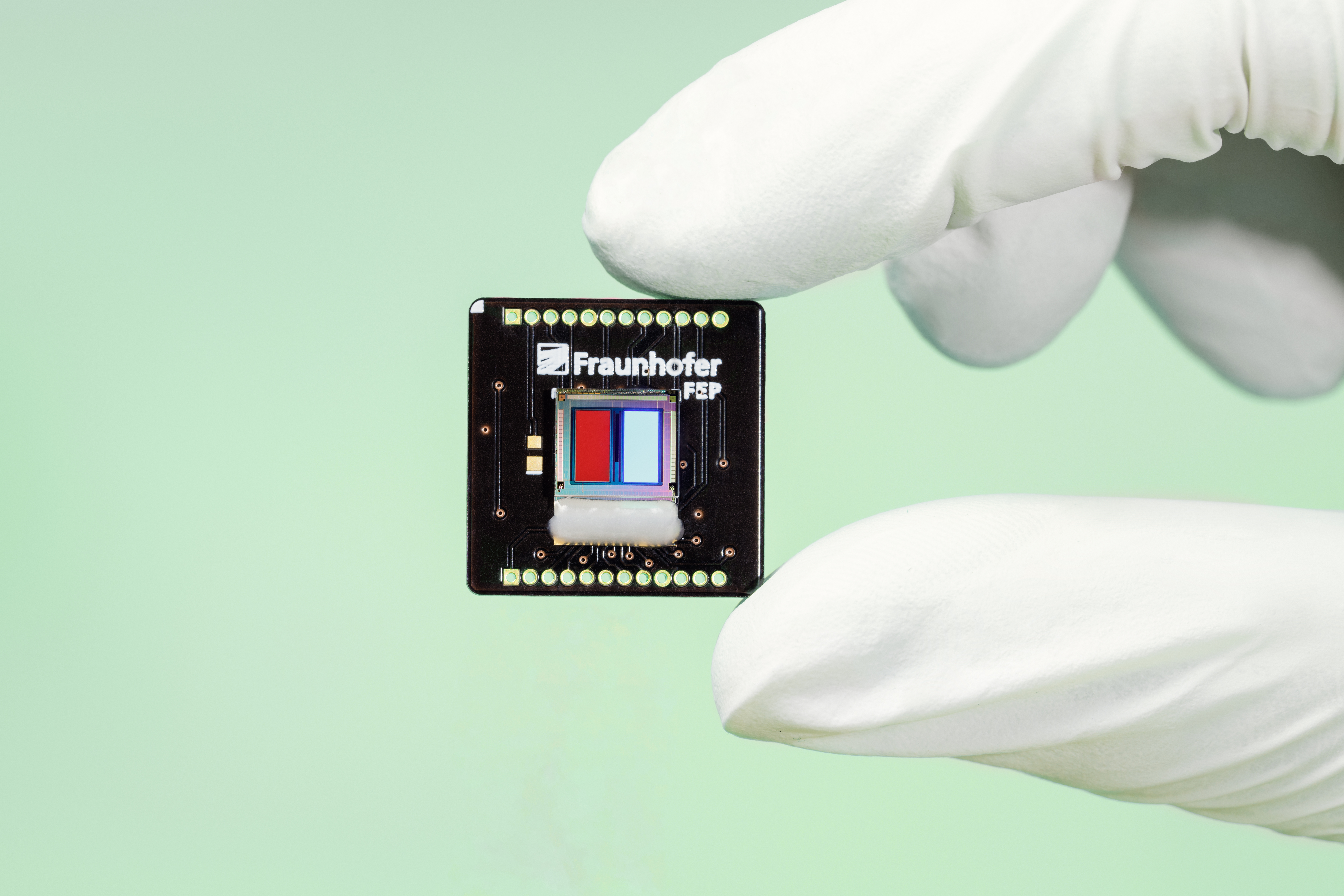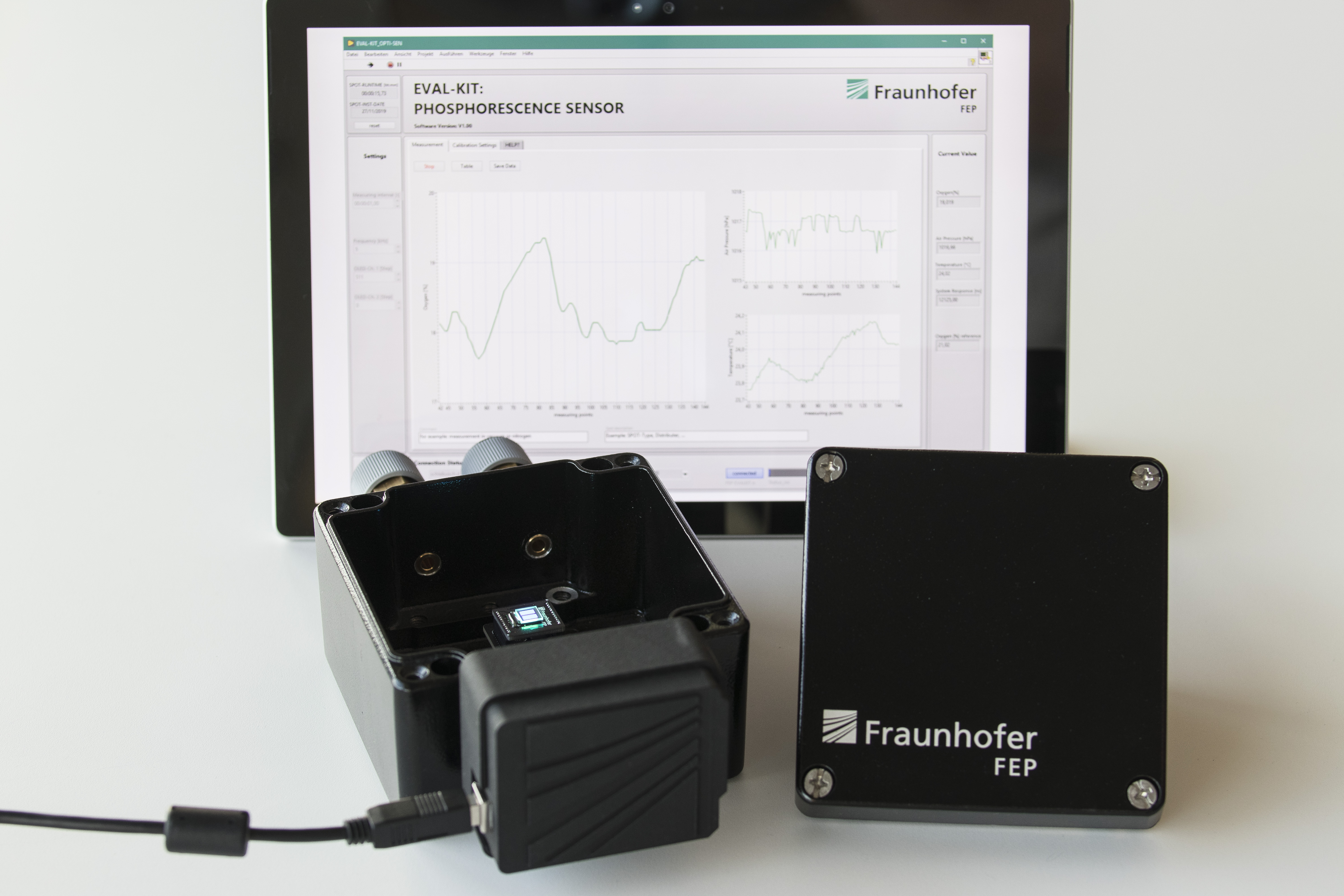Universal gas sensor platform with improved thin-film encapsulationg
Optical sensors for determining oxygen concentration can be used in the biomedical, pharmaceutical or even food industries and for monitoring conditions in water or bioreactors. Depending on the application, parameters such as the size of the overall system of control and readout unit and price play a decisive role in the selection of the sensor solution. At the Fraunhofer Institute for Organic Electronics, Electron Beam and Plasma Technology FEP, the processing of miniaturized phosphorescence sensors based on OLED-on-silicon technology and with the smallest chip area was developed further. The resulting universal gas sensor platform with improved thin-film encapsulation will be presented at IEEE Sensors 2023 in Vienna, Austria, from October 29 to November 1, 2023.
Sensors for determining the concentration of certain gases in the environment can be found in a wide range of applications. In particular, gas sensors for the determination of oxygen concentration can be used in food production, environmental monitoring for the measurement of oxygen content in waters or oceans up to medical devices for breath analysis. The choice of the appropriate gas sensor always depends on the specific requirements of the application, such as accuracy, response time or environmental factors, but also on the price and size of the system.
Considering only the class of oxygen sensors, there are many optical sensors on the market which are difficult to miniaturize due to their separate LED, filter and sensor components. Ultra-flat OLED light sources integrated directly on the CMOS chip overcome these hurdles and are attractive alternatives due to their ease of use and integration into existing systems.
Fraunhofer FEP has many years of expertise in the development and production of highly integrated electro-optical components based on OLED-on-silicon technology. In addition to the realization of various OLED microdisplays, the scientists also use the technology for optical sensor solutions.
This has already resulted in a miniaturized phosphorescence sensor wherein a marker dye on top of the OLED-on-Silicon chip is in direct contact to the oxygen process, and excited by modulated blue OLED light, whereas the phosphorescence response is directly detected within the sensor chip. Depending on the used dye, other gases or even pH values, pressure and temperature can be measured in addition to the oxygen concentration in future.
Currently there are no commercial solutions on the market for comparable sensor chips for the excitation and readout of dyes including control on a chip area of less than 8 × 8 mm. This makes it significantly smaller than previous setups for excitation and measurement of dyes for concentration and state determination of gases. The decay time of the dye phosphorescence is a parameter for the oxygen concentration of the environment. The significantly lower phosphorescence signal with increasing oxygen concentration is detected via integrated silicon photodiodes, locally amplified in the chip and subsequently evaluated with regard to the phase shift to the excitation signal.
These existing sensor chips were processed in a rather complex process with a former “Vitex” thin-film encapsulation, which consisted of a combination of sputtered oxide layers as a barrier against oxygen and water and several organic smoothing layers. A disadvantage of this encapsulation technology is the high cost, requiring at least 2–3 process chambers and challenging the stability of the process parameters. In addition, particle loading reduces the yield when processing these sensor chips. Factors that are reflected in the manufacturing costs and complicate the transfer to industry.
In order to increase the yields of the sensor chips and to be able to offer even smaller chips in the future, Fraunhofer FEP focused, among other things, on optimizing the encapsulation technology within the AquaSens project funded by the German Federal Ministry for Economic Affairs and Climate Action. The results are significantly improved gas sensor chips for oxygen measurement on a very small area.
Project manager Dr. Karsten Fehse explains: "To optimize the overall chip, we have established a new encapsulation layer consisting of an atomic layer deposition (ALD) barrier layer. A major advantage here is that we only need one process chamber for this, which can reduce the process steps and costs enormously. In addition, the process now is much lower in particles, and we get fewer defects in the encapsulation layers of the sensor chips, which of course increases the yields. In addition, the new ALD technology allows us to set the layer thicknesses of the individual layers very precisely, giving us high reproducibility of the encapsulation barrier."
The scientists have already carried out initial aging tests on chips with and without additional glass encapsulation. The yield of the sensor chips when stored for 90 days at 85% relative humidity and 85°C was significantly higher than that of the previous “Vitex”-encapsulated samples. These positive results under the very high requirements for organic devices demonstrate the stability and usability of the organic-CMOS combination for sensor applications. Furthermore, first demonstrators for oxygen measurement have already been implemented and evaluated for concentration determination in air and water. The miniaturized sensor concept has been able to determine the oxygen concentration between 0 to 20% in air comparable to literature values.
In addition to optimizing the encapsulation of the sensor chips, the researchers at Fraunhofer FEP want to reduce the overall chip size to less than 2 × 2 mm in the future. Karsten Fehse explains: "One of the challenges of further miniaturization is the optical separation of light generation and detection. This is because the closer the light generation by the OLEDs gets to the silicon photodiodes, i.e. the chip becomes smaller, the more difficult it is to achieve this optical separation. With poor signal separation, the photodiode detects only the OLED signal, but not the dye response signal. With our know-how in chip development, we are working on solutions for this by adapting the light emission characteristics of the OLEDs and integrating color filters on the chip.”
The developed sensor chip for oxygen determination is already available at Fraunhofer FEP and will be presented at the IEEE Sensors 2023 in Vienna, from October 29 to November 1, 2023 at booth #6 as well as in a lecture. The scientists are open for discussions for validation and further development of the sensor chips. For the development of customized sensors depending on the desired application, Fraunhofer FEP also has an established network to leading dye manufacturers for the sensor markers.
About the project AquaSens
LocaSenZ - AquaSens
Optical sensor front-end for a fluorescence optical dissolved oxygen sensor in aqua cultures
Funded by: Federal Ministry for Economic Affairs and Climate Action
Funding reference: 16KN090725
Duration: 01.06.2021 - 31.05.2023
Fraunhofer FEP at IEEE Sensors 2023
IEEE Sensors 2023
29. October – 1. November 2023
Hilton Vienna Park, Vienna, Austria
https://2023.ieee-sensorsconference.org/
Booth no. 6
Poster Session
Optical Sensors – B
Poster Area 5
1. November 2023, 1:30 – 3:00 pm
Chairs: Karsten Fehse
Lecture
Optical Sensors – 3 Session
1. November 2023, 16:15 pm, room 7
1135: Combination of Organic and Inorganic Semiconductor for Sensing Applications
Dr. Karsten Fehse et al.
Further Publications on the topic
- Organic-on-silicon photonic platform for advanced imagers, microdisplays and sensors
Wartenberg et. al, 2023, Smart Photonic and Optoelectronic Integrated Circuits 2023 - CMOS-integrierte Lichtemitter für optische Sensorik und Mikrodisplays
Fehse, Karsten; Richter, Bernd; Schedwill, Ines
2020, Photonik - Integration organischer Leuchtdioden auf einem Sensorchip zur Messung der Sauerstoffkonzentration in Gasen und Flüssigkeiten
Fehse, Karsten et. al.
2019, 14. Dresdner Sensor-Symposium 2019
 Fraunhofer Institute for Electron Beam
Fraunhofer Institute for Electron Beam
